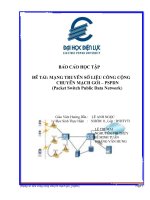Ch5 2 v1 TRUYỀN SỐ LIỆU VÀ MẠNG
Bạn đang xem bản rút gọn của tài liệu. Xem và tải ngay bản đầy đủ của tài liệu tại đây (332.05 KB, 14 trang )
Chapter 5
Analog Transmission
5.1
Copyright © The McGraw-Hill Companies, Inc. Permission required for reproduction or display.
5-2 ANALOG AND DIGITAL
Analog-to-analog conversion is the representation of
analog information by an analog signal. One may ask
why we need to modulate an analog signal; it is
already analog. Modulation is needed if the medium is
bandpass in nature or if only a bandpass channel is
available to us.
Topics discussed in this section:
Amplitude Modulation
Frequency Modulation
Phase Modulation
5.2
Figure 5.15 Types of analog-to-analog modulation
5.3
Amplitude Modulation
5.4
A carrier signal is modulated only in
amplitude value
The modulating signal is the envelope of
the carrier
The required bandwidth is 2B, where B is
the bandwidth of the modulating signal
Since on both sides of the carrier freq.
fc, the spectrum is identical, we can
discard one half, thus requiring a
smaller bandwidth for transmission.
Figure 5.16 Amplitude modulation
5.5
Note
The total bandwidth required for AM
can be determined
from the bandwidth of the audio
signal: BAM = 2B.
5.6
Figure 5.17 AM band allocation
5.7
Frequency Modulation
5.8
The modulating signal changes
the freq. fc of the carrier
signal
The bandwidth for FM is high
It is approx. 10x the signal
frequency
Note
The total bandwidth required for FM can
be determined from the bandwidth
of the audio signal: BFM = 2(1 + β)B.
Where is usually 4.
5.9
Figure 5.18 Frequency modulation
5.10
Figure 5.19 FM band allocation
5.11
Phase Modulation (PM)
5.12
The modulating signal only changes
the phase of the carrier signal.
The phase change manifests itself
as a frequency change but the
instantaneous frequency change is
proportional to the derivative of
the amplitude.
The bandwidth is higher than for
AM.
Figure 5.20 Phase modulation
5.13
Note
The total bandwidth required for PM can
be determined from the bandwidth
and maximum amplitude of the
modulating signal:
BPM = 2(1 + β)B.
Where = 2 most often.
5.14









